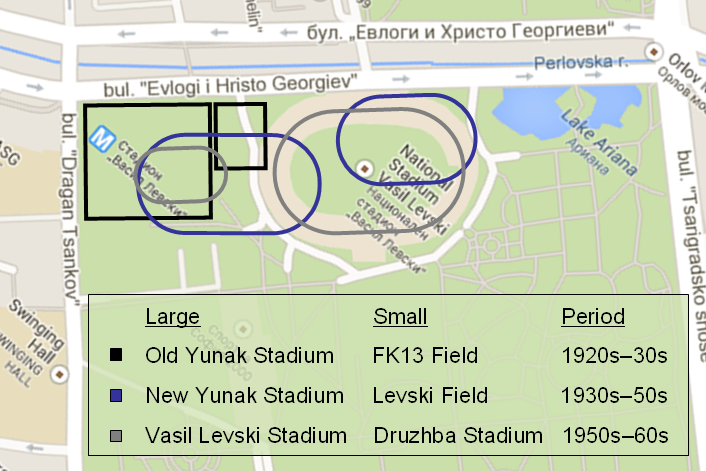Yunak Stadium on:
[Wikipedia]
[Google]
[Amazon]
Yunak Stadium (Bulgarian: ''Стадион Юнак'', ''Stadion Yunak''), was a multi-use  In the 1920s–30s, immediately to the northeast of Yunak stadium, was built the smaller
In the 1920s–30s, immediately to the northeast of Yunak stadium, was built the smaller Live chess games at Yunak Stadium (1936)
Old Sofia
'. Retrieved Nov 2012.
stadium
A stadium ( : stadiums or stadia) is a place or venue for (mostly) outdoor sports, concerts, or other events and consists of a field or stage either partly or completely surrounded by a tiered structure designed to allow spectators to stand o ...
in central Sofia
Sofia ( ; bg, София, Sofiya, ) is the capital and largest city of Bulgaria. It is situated in the Sofia Valley at the foot of the Vitosha mountain in the western parts of the country. The city is built west of the Iskar river, and ha ...
, Bulgaria
Bulgaria (; bg, България, Bǎlgariya), officially the Republic of Bulgaria,, ) is a country in Southeast Europe. It is situated on the eastern flank of the Balkans, and is bordered by Romania to the north, Serbia and North Macedon ...
. It was located at the north-western corner of Knyaz Boris's Garden, on the southern bank of the Perlovska river. It was the largest stadium in Bulgaria until the middle of the 20th century, with a capacity of 35,000 spectators, and was initially used as the main stadium for Bulgaria national football team
The Bulgaria national football team ( bg, Български национален отбор по футбол, Bǎlgarski natsionalen otbor po futbol) represents Bulgaria in men's international Association football, football and is administere ...
matches. The pitch was almost exactly square-shaped, with four straight rows of stands on all sides.
The stadium is named after the Yunak sports societies which formed in Bulgaria in the late 19th century, themselves named after the word "yunak", meaning a strong young man.
 In the 1920s–30s, immediately to the northeast of Yunak stadium, was built the smaller
In the 1920s–30s, immediately to the northeast of Yunak stadium, was built the smaller Levski Field
Levski Playing Field ( bg, Игрище „Левски“, Igrishte Levski) was the original stadium of Levski Sofia football club. It was commissioned in 1924 and completed in 1934. In 1944 it had a seating capacity of 10,000.
The stadium was ...
, the home ground of SK Levski. In the 1950s, the BCP decided to build a new, larger national stadium on the site of Levski Field. As the new stadium would infringe on the north-eastern stands of the Yunak stadium, this was also demolished in order to make way for the Vasil Levski National Stadium
Vasil Levski National Stadium ( bg, Национален стадион „Васил Левски“), named after Bulgarian national hero and revolutionary Vasil Levski (1837–1873), is the country's second largest stadium. The stadium has 43,2 ...
, opened 1953. Because of this, Dinamo Sofia were given a new home in the north-eastern suburbs of the capital, while in the place of Yunak was built the much smaller Druzhba ("Friendship") stadium, which was used for many years as an ice rink
An ice rink (or ice skating rink) is a frozen body of water and/or an artificial sheet of ice created using hardened chemicals where people can ice skate or play winter sports. Ice rinks are also used for exhibitions, contests and ice shows. The ...
.
After the fall of communism, the disused ice rink regained the name of the original Yunak stadium, but was never again used as a sports facility and, as of the early 2000s, lies in ruins, which are visible between the national stadium and the Sofia Metro
The Sofia Metro ( bg, Софийски метрополитен, translit=Sofijski Metropoliten, also colloquially called ) is the rapid transit network servicing the Bulgarian capital city Sofia. It began operation on 28 January 1998. , the Sofi ...
station that formerly bore the same name.
The stadium has also been used for unorthodox "sports", such as live human chess during the reign of Tsar Boris
Boris I, also known as Boris-Mihail (Michael) and ''Bogoris'' ( cu, Борисъ А҃ / Борисъ-Михаилъ bg, Борис I / Борис-Михаил; died 2 May 907), was the ruler of the First Bulgarian Empire in 852–889. At ...
.Old Sofia
'. Retrieved Nov 2012.
References
{{reflist Defunct football venues in Bulgaria Sports venues in Sofia History of Sofia Sports venues completed in 1928 1928 establishments in Bulgaria